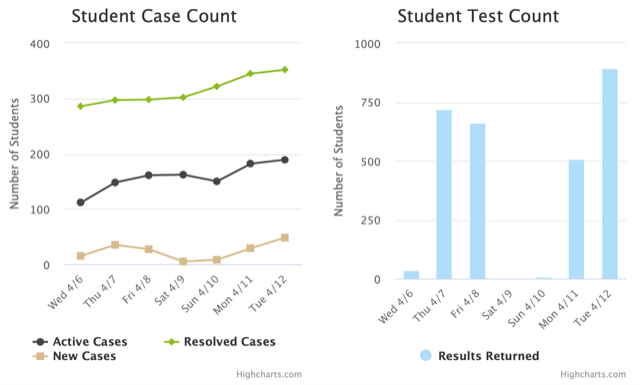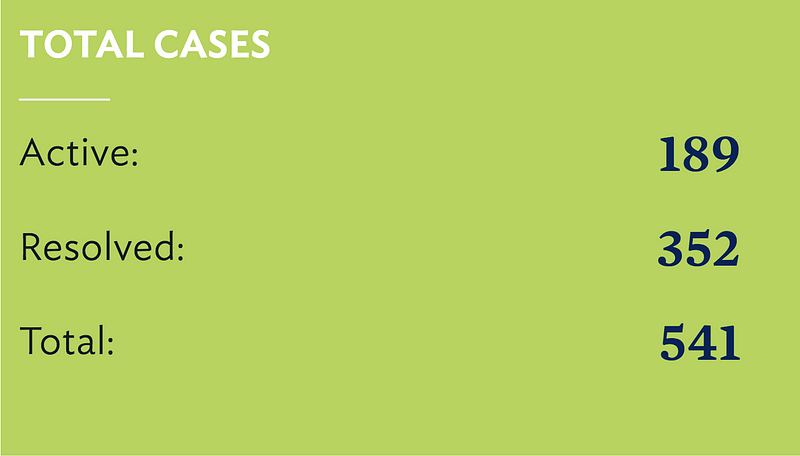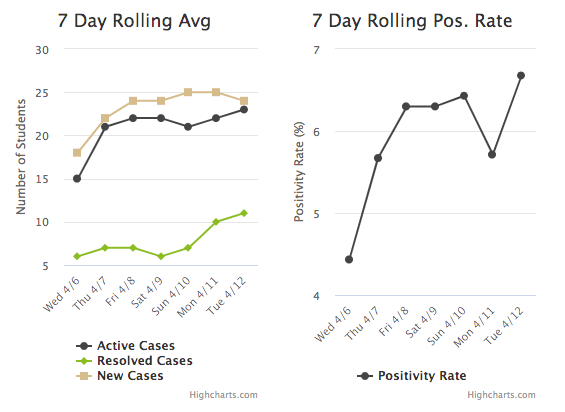
The most recent data available displays a record-high number of COVID-19 cases in students. Photo courtesy of Hamilton College COVID-19 Dashboard.
As of Wednesday, April 13, there are 189 active student cases, up from 103 last week. The whole of Oneida County currently has 718 active COVID-19 cases, of which 26.3% are Hamilton students.
Testing from Monday, April 11 returned 77 positive results out of 1403 tests, a positivity rate of 5.49%. The College has had a total of 541 student cases since January, meaning that over a quarter of students have contracted COVID-19 this semester.
On Wednesday, April 13, the COVID-19 Task Force stated, “Effective Friday, indoor events with food will not be allowed until further notice.” Outdoor events are allowed to proceed, and the College urges students to take advantage of the Adirondack chairs and canopies, including the rebuilt Dunham Green tent. The email also reiterated that masks are now required indoors. Students are allowed to unmask in residence halls “unless maintenance staff are present”.
The spike in cases has led to many questions from students and faculty about the future of campus regulations. The mask mandate, off-campus accommodation and class locations all come under questioning. Below is an interview with Chair of the COVID-19 Task Force, and Vice President for Administration and Finance, Karen Leach.
Is there a high chance of us going into Yellow status? (Are there specific criteria for going into Yellow? What positivity rate? The guidelines on the operating status grid from the beginning of this semester are understandably vague).
We can’t really predict if we will have a change in status. Many factors go into the decision including what is happening on campus, in the region, and nationally.
Currently, is there a possibility of the classes at Hamilton College going virtual?
We have no plans to shut down the campus as we did in Spring 2020. Yellow status, if we went there, would allow professors to choose in person, hybrid, or remote classes. But, we hope we don’t need to do that and we can finish out the semester with in-person classes.
Should students take a rapid test if they are a close contact, and do positive rapid tests immediately trigger the quarantine process and count them as a case?
Students who are close contacts should immediately wear a mask and take a rapid test on day four or five after exposure. It takes time for the virus to grow. If they develop symptoms sooner, they should call the Health Center for a test or take a rapid test and report it to the Health Center if it is positive.
Yes, students who report a positive rapid test to the Health Center will be moved to isolation and are counted as a case.
Are all students currently quarantined off-campus? Will the College switch to in-room isolation as cases increase?
Yes, all students currently in isolation are off campus, either in the hotels or they have gone home if they live in driving distance and have transportation. We have a plan for in-room isolation but we hope we don’t have to use it.

Photo courtesy of Hamilton College COVID-19 Dashboard.
What steps can the College take to mitigate spread beyond mandating masks? Is it possible for the College to enforce social distancing in classrooms, for example?
There is no evidence of classroom spread. Transmission appears to be coming from out of class activities. Everyone can help stop the spread by wearing a mask as much as possible and avoiding unmasked events.
How is the COVID-19 task force organized? Do all members attend regular meetings, or are there smaller subgroups?
There are 16 members on the Task Force including people who organize the testing, hotels and medical response. There are also members from student life, academic affairs, facilities management, human resources and two faculty members from science. We currently have three students on the Taskforce and during the past two years at least eight different students have been on the group. There is also a Steering Committee and several action groups. The Taskforce meets once a week and the Steering Committee meets twice a week if needed.
How much are the student representatives involved in the decision making process?
Student reps regularly and frequently provide input on a change we may make or a new policy we may implement. Like other members of the Task Force, they have great insights and always engage in a good debate of the pros and cons. Their insights and opinions are invaluable.

Photo courtesy of Hamilton College COVID-19 Dashboard.
In hindsight, does the task force regret not mandating masks when students returned from spring break?
It’s always easy to second-guess a decision in hindsight. Cases on campus were declining prior to the break. We provided rapid tests to students to use prior to their return. Many other schools brought their students back from break without a spike in cases. It’s unfortunate that we did not have the same experience. Some of those schools experienced surges earlier in the semester and we are following the path that they did to eventually get to lower case counts.
Leach concluded the interview by noting that “another thing to remember is that everybody is vaccinated now. That was not the case in the spring of 2020!”
The COVID-19 Task Force will meet on Tuesday, April 19, to evaluate whether further changes in current COVID policies are needed. If the College were to go into Yellow status, this would mean a big shift in daily practices, with similar regulations as those students faced in the 2020–2021 school year.
Testing would increase to three times a week, with masks mandated in both indoor spaces and outdoors within six feet of others. Dining would shift to take-out, with reduced interaction. Athletic practices and competitions would likely be suspended. More information about each status can be found on the Campus Operating Grid on the COVID-19 Dashboard.
Currently, Hamilton College strictly enforces a biweekly testing policy on Mondays and Thursdays, meaning that positive cases are caught relatively quickly. Students are penalized with two disciplinary points if they miss a COVID test and do not make it up at the next available opportunity, surpassing the sanctions for underage students breaking the law by possessing alcohol or marijuana. Receiving six disciplinary points puts a student on disciplinary probation and impacts their housing lottery placement.
However, other schools’ more relaxed testing requirements mean that cases may be severely underreported, making comparison difficult. For instance, Colgate University does not require vaccinated students to take any COVID-19 tests, stating on their website: “At this time, if you are not having symptoms and are not a close contact, no testing is necessary.” This means that many asymptomatic cases likely go undetected, especially with the BA.2 variant.
Comparing Hamilton’s COVID-19 cases this semester (541 total, 189 active) with our NESCAC peers that have similar testing requirements and enrollment may provide a more accurate comparison.
Bates College and Bowdoin College both have mandatory testing twice a week. Bates had 339 total cases this semester, and currently has 24 active student cases. Bowdoin had 340 total cases, with 103 currently active.
Colby College has had 361 total cases this semester, with 19 active student cases. Like Hamilton, Colby is administering PCR tests via the Broad Institute, and has processed 59,518 tests this semester.
Williams College has had 553 total cases, with 19 currently active. Their current mask mandate is similar to Hamilton’s Blue Status one, with masks mandatory in classes, COVID-19 testing sites and the Health Center, but optional in most indoor spaces.
The most recent email sent by the COVID-19 Task Force urges students to “adhere to our safety protocols, think of others, and do the things we have all learned help keep us safe,” ending with the message, “Stay positive, and let’s all… work together to finish the semester strong.”